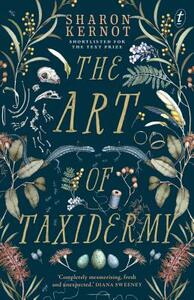You need to sign in or sign up before continuing.
Take a photo of a barcode or cover
The Art of Taxidermy by Sharon Kernot felt like it was written for me. While my emotional circumstances didn’t align with the narrator, Lottie, everything else in the story felt so familiar that it really resonated. I chose The Art of Taxidermy as my book for my May Reading Challenge, and for the theme, I chose a book depicting my country. Honestly, I couldn’t have picked a better one.
The Art of Taxidermy is a slow burn, and I must admit, it wasn’t at all what I was expecting. It’s described as a novel, but it’s more than that. Essentially, it’s a piece of narrative poetry, and as such, is a short read. But Kernot really does a lot in minimal space. Her prose is deliberate and tightly woven. Because of the style and structure, not a word is out of place. There wasn’t a deep plot, or any unexpected twists and turns, but what it did show was a very personal look at grief and the beauty that can be found in death.
Australian flora and fauna are an integral part of The Art of Taxidermy, and as such, I’m not sure how much a non-Australian would get from it. This novel resonated with me so deeply because I felt a familiarity with its people and setting. Lottie’s family are German, and the prose is speckled with German words which are not always translated. Coming from a bi-lingual Australian/German family, once again, this was something that really resonated with me, but made me question just how much a reader not immersed in that culture would really understand in the nuances.
There isn’t a great deal of world-building, nor particularly in-depth characterisation in The Art of Taxidermy, but that didn’t matter. It wasn’t that kind of book. Reading it is more about the experience of it, rather than the enjoyment – and for that, I was glad of its relatively short length. Had it been any longer I think it could have become boring, but any shorter and it would have felt lacking. It was a pretty much perfect showcase of unique style and subtle story without overstaying its welcome.
I don’t think The Art of Taxidermy will be everyone’s cup of tea. I think it will appeal to a particular audience. So, if you’re like me and you’re an Australian/German with nostalgia for your home who is bi-lingual and has a love for Natural History collections, then this book was written for you. Alternatively, if you like unique structure and beautiful prose that probes the subtleties of the human condition, then this book might also be for you. There’s no doubt about it, The Art of Taxidermy is an ‘artsy’ book that needs to be experienced rather than simply read. If that’s the kind of book you like, then this will be right up your street.
The Art of Taxidermy is a slow burn, and I must admit, it wasn’t at all what I was expecting. It’s described as a novel, but it’s more than that. Essentially, it’s a piece of narrative poetry, and as such, is a short read. But Kernot really does a lot in minimal space. Her prose is deliberate and tightly woven. Because of the style and structure, not a word is out of place. There wasn’t a deep plot, or any unexpected twists and turns, but what it did show was a very personal look at grief and the beauty that can be found in death.
Australian flora and fauna are an integral part of The Art of Taxidermy, and as such, I’m not sure how much a non-Australian would get from it. This novel resonated with me so deeply because I felt a familiarity with its people and setting. Lottie’s family are German, and the prose is speckled with German words which are not always translated. Coming from a bi-lingual Australian/German family, once again, this was something that really resonated with me, but made me question just how much a reader not immersed in that culture would really understand in the nuances.
The corellas were grazingThere are some stunningly visceral descriptions of death, dying, and decay. While these may not be for everyone, I found them oddly beautiful. There is beauty in the fragility of life, and artistry in capturing those moments, and it was refreshing to see those things represented in a way that was more than merely violent and gruesome. It was a hopeful, loving novel, but still punctuated by an undercurrent of grief and loneliness. It was like the human condition was distilled into a few pages of prose, and I thought it was done masterfully.
with a scatter of galahs.
We sat on a fallen log
and watched them squabble and tussle,
beat their wings and waddle
like hook-nosed old men
with their arms tucked
behind their backs.
There isn’t a great deal of world-building, nor particularly in-depth characterisation in The Art of Taxidermy, but that didn’t matter. It wasn’t that kind of book. Reading it is more about the experience of it, rather than the enjoyment – and for that, I was glad of its relatively short length. Had it been any longer I think it could have become boring, but any shorter and it would have felt lacking. It was a pretty much perfect showcase of unique style and subtle story without overstaying its welcome.
I don’t think The Art of Taxidermy will be everyone’s cup of tea. I think it will appeal to a particular audience. So, if you’re like me and you’re an Australian/German with nostalgia for your home who is bi-lingual and has a love for Natural History collections, then this book was written for you. Alternatively, if you like unique structure and beautiful prose that probes the subtleties of the human condition, then this book might also be for you. There’s no doubt about it, The Art of Taxidermy is an ‘artsy’ book that needs to be experienced rather than simply read. If that’s the kind of book you like, then this will be right up your street.
A beautiful book. Slow, quiet and sad, filled equally with life and death. Such gorgeous language and filled with heart, I adore this book.
ARC provided by the Publishers via NetGalley in exchange for an honest review
Publication Date 23 Aug 2019
I wanted flesh and blood,
not ghosts.
A disappointing book with interesting intentions but a lacklustre execution.
I feel like the format could have really worked with the themes discussed in the book- fragmented style reflecting grief etc but it was lacking in plot due to the inability to introduce a conflict effectively. Some 'poems' were purely exposition and others were purely abstract yet all were lacking in a strong voice that I feel like a collection like this really needs.
Unfortunately, I feel like the same effect could have been had with a short story format or in a poetry pamphlet.
The imagery was morose and effective for the purpose of the book. However, it became repetitive very quickly. This is the same for the motifs and symbols used.
A format that I would find more interesting would have been if the book was written from alternating perspectives in a similar way to [b:The Bluest Eye|11337|The Bluest Eye|Toni Morrison|https://images.gr-assets.com/books/1388208495s/11337.jpg|1987778] by [a:Toni Morrison|3534|Toni Morrison|https://images.gr-assets.com/authors/1494211316p2/3534.jpg]. Different perspectives could have allowed for a detached observation of Lottie and alienated her from the reader in the same way she feels alienated from her peers. Her perspective would have been a breath of fresh air if this was the case.
Publication Date 23 Aug 2019
I wanted flesh and blood,
not ghosts.
A disappointing book with interesting intentions but a lacklustre execution.
I feel like the format could have really worked with the themes discussed in the book- fragmented style reflecting grief etc but it was lacking in plot due to the inability to introduce a conflict effectively. Some 'poems' were purely exposition and others were purely abstract yet all were lacking in a strong voice that I feel like a collection like this really needs.
Unfortunately, I feel like the same effect could have been had with a short story format or in a poetry pamphlet.
The imagery was morose and effective for the purpose of the book. However, it became repetitive very quickly. This is the same for the motifs and symbols used.
A format that I would find more interesting would have been if the book was written from alternating perspectives in a similar way to [b:The Bluest Eye|11337|The Bluest Eye|Toni Morrison|https://images.gr-assets.com/books/1388208495s/11337.jpg|1987778] by [a:Toni Morrison|3534|Toni Morrison|https://images.gr-assets.com/authors/1494211316p2/3534.jpg]. Different perspectives could have allowed for a detached observation of Lottie and alienated her from the reader in the same way she feels alienated from her peers. Her perspective would have been a breath of fresh air if this was the case.
Exquisite! If I could stop lazing off, I would've written up a whole unit of work for my students, but nah, ceebs...
I requested this book because I've loved most of the verse novels I've read so far, but this is a no from me.
The writing style is actually good, but the descriptions of dead and decaying animals really grossed me out (although I concede that that's a me thing). For most of this book, I was just kind of bored, and I found that it wasn't really for me. So nothing too amazing, but nothing too terrible either.
But then... Did this white author... really have to use the N word? Short answer: no, not at all, not ever. Yikes. And I've somehow not seen this mentioned in any of the reviews I've read? I actually stopped reading right after seeing this, because that's honestly all I need to know. (Page 170 btw, for reference.) This book is set to come out in August so I sincerely hope this will get rectified in the finished copy.
The writing style is actually good, but the descriptions of dead and decaying animals really grossed me out (although I concede that that's a me thing). For most of this book, I was just kind of bored, and I found that it wasn't really for me. So nothing too amazing, but nothing too terrible either.
But then... Did this white author... really have to use the N word? Short answer: no, not at all, not ever. Yikes. And I've somehow not seen this mentioned in any of the reviews I've read? I actually stopped reading right after seeing this, because that's honestly all I need to know. (Page 170 btw, for reference.) This book is set to come out in August so I sincerely hope this will get rectified in the finished copy.
"received an arc exchange for an honest review"
dnf @ 45%
loved how it was written in verse but i didn't expect it to be all about death and how somebody can be so obsessed about it
dnf @ 45%
loved how it was written in verse but i didn't expect it to be all about death and how somebody can be so obsessed about it
Went into this not really knowing anything about it and I have to say it was unlike anything I’ve ever read. It was a whole take on grief and lotties obsession with taxidermy being about wanting to preserve and show the beauty in death.
Books written in verse are some of my favourites, and although normally books like this would have me sobbing, something about this just didn’t connect with me. However would still recommend it as was a quick and interesting read!
Books written in verse are some of my favourites, and although normally books like this would have me sobbing, something about this just didn’t connect with me. However would still recommend it as was a quick and interesting read!
This was a heartbreaking book and when I requested it on Netgalley, I did not expect it to be in verse but I think it was done really well. I got really into the story and sped through it in a couple of hours.






